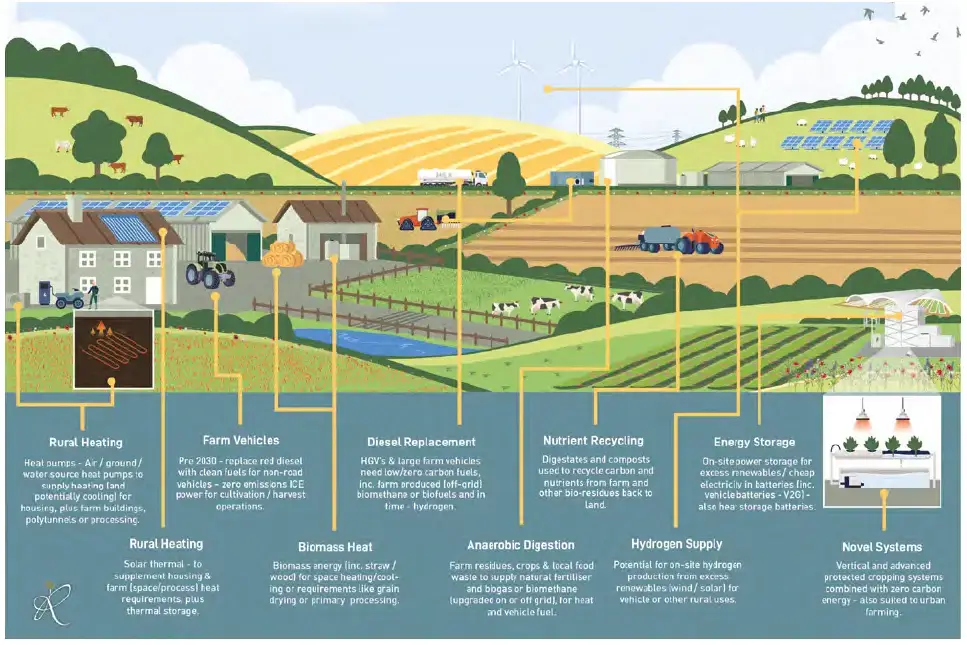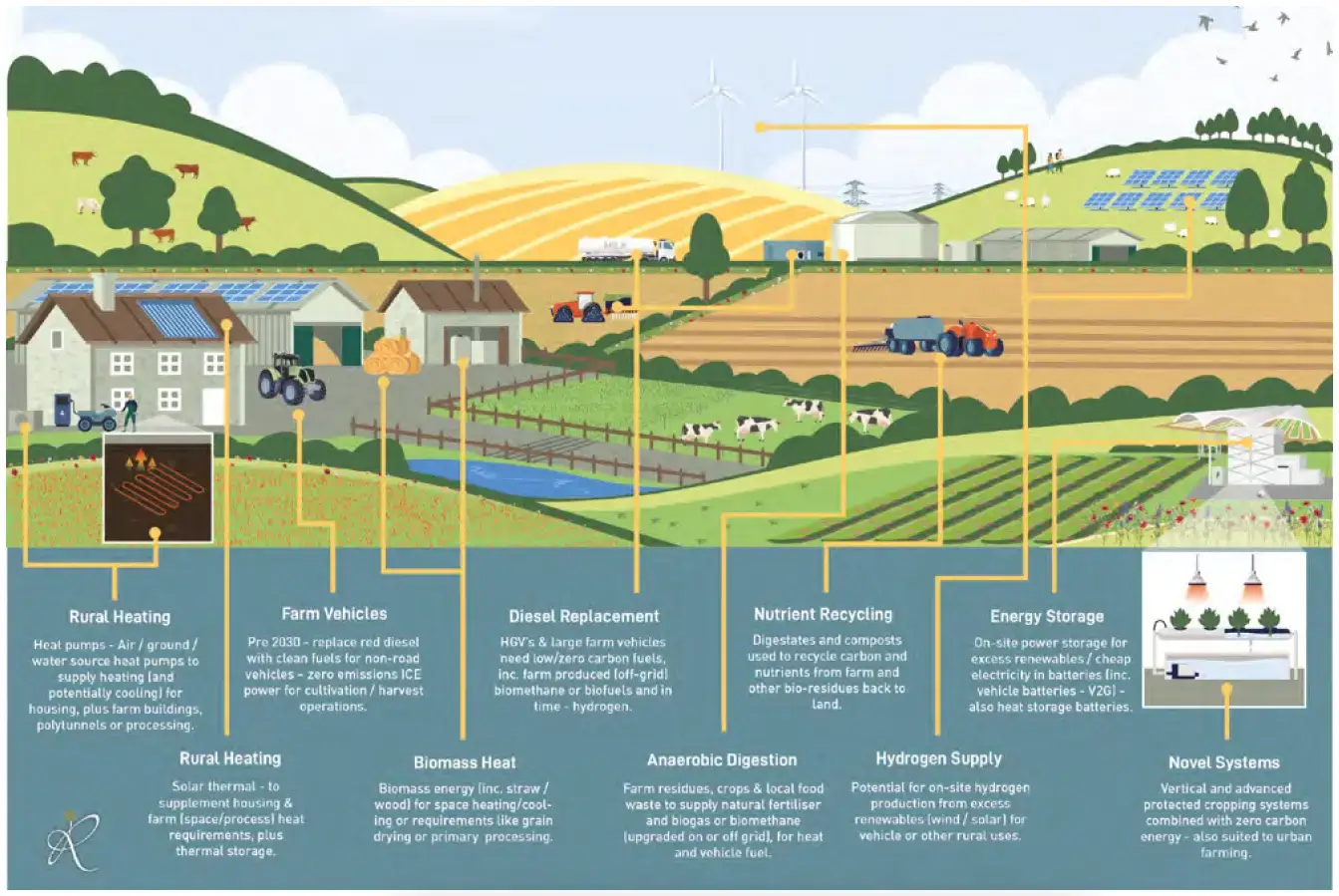A transition to a low carbon economy requires reducing food production reliance on fossil fuels as much as possible, as well as reducing other greenhouse gas emissions.
Although agriculture contributes less than 1% to the UK’s economy, farmers and land managers take care of nearly 70% of the land area and provide roughly 60% of the nation’s food by supply-chain value. Agriculture is responsible for around 12% of the UK’s territorial CO2e emissions.
While the sector contributes only 1% of the UK’s CO2 emissions (largely from on-farm energy use), it producing 49% of the UK’s methane and 70% of the nitrous oxide emissions. Methane from ruminants represents 85% of total annual UK agricultural methane emissions with the majority of nitrous oxide emissions resulting from fertiliser application. These figures do not consider any offsets at farm level, for example, from low carbon or sequestration initiatives, but much still needs to be done.
Many farmers have chosen renewable energy generation as part of farm diversification. With 71% of farm businesses in England engaging in some diversified activity in 2023/24 , renewable energy is a leading option: about 27% of farms have on-site solar PV installations (up from 22% in 2019/20) , and around 10–12% have other renewable sources such as wind turbines, biomass boilers, or AD plants.
The introduction of a single renewable energy technology can act as a gateway to integrate complementary technologies and practices to reduce carbon emissions across a farm business. The Caerfai Farm, Copys Green Farm and Marsh Farm case studies illustrate this.


On-farm low and zero carbon renewable energy
Farm energy storage
The addition of farm-level battery storage is becoming an increasingly attractive option as battery costs fall, particularly where intermittent renewable energy, such as on-site wind or solar, is available. The farm’s electricity requirements must justify the use of battery energy storage, and with intermittent renewable energy production, matching energy use to energy production is essential.
Energy storage such as battery, pumped storage hydropower (PSH) and electrolysis, is an important part of being able to extend the hours of energy use.
On-site farm energy generation options
Heat pumps
Heat pumps are likely to be an increasingly attractive option, especially for heating properties not on the gas grid. Such installations require a thorough assessment of the building fabric, insulation and airtightness to be able to size an installation properly. It is also perfectly possible to use heat pumps in older buildings or to have a hybrid system which includes an LPG boiler and a heat pump.
Anaerobic digestion
Farm-scale anaerobic digestion (AD) based on livestock, local food waste and crop residues, particularly at small scale, has massive potential to provide 24/7 energy production which can be used flexibly for heat, electricity and transport fuels. Unlike other renewable energy systems, AD has further important non-energy benefits including fossil fertiliser replacement, weed seed reduction and improved animal health, with treated digestate spread on grazing land, replacing raw slurry. There is still a policy gap to support smaller systems, particularly for their environmental benefits on livestock farms.
Hydropower
Where a suitable watercourse is available, small hydropower projects can provide farms, communities and businesses with a non-intermittent supply of renewable electricity. As a rural resource, there needs to be on-going support for such projects. A number of these have also been built by community energy initiatives, providing wider rural benefits. The Renewable Energy Foundation FIT register shows that hydropower provides a contribution of 247.79 MW to the UK’s energy supply.
| Type | England | Scotland | Wales | Total |
|---|---|---|---|---|
| Domestic {.3-100kW] | 140 (1.95 MW) | 130 (2.19 MW) | 111 (1.50 MW) | 385 (5.79 MW) |
| Community [4-500kW] | 24 (0.85 MW) | 17 (2.15 MW) | 14 (0.79 MW) | 56 (4.29 MW) |
| Commercial [3-2253kW] | 134 (16.21 MW) | 383 (160.64 MW) | 153 (14.14 MW) | 736 (230.13 MW) |
Domestic, community and commercial UK hydro installations (and power) in receipt of FIT by country. Source: REF
Community energy
Community energy initiatives such as those supported through the Rural Community Energy Fund (RCEF) need continued support to make important contributions in identifying and addressing specific rural community energy needs, particularly for those not connected to the mains gas grid or where housing stock is energy inefficient.
Community groups facilitate much more than just energy generation. They support skilled rural jobs, provide wider social benefit, act as a knowledge hub and engage people in a collective drive to net zero.
Integration of on-farm energy systems
The integration of on-site energy systems, within the farm itself and as part of the grid is an exciting growth area, particularly with the development of smart devices and energy supplier tariff schemes which enables users to prioritise and automate energy use. This enables electricity from solar and small on-site wind turbines to be preferentially used on-site in a ‘cascading’ priority of uses, for example, firstly for space heating, then to dairy hot water and finally to office hot water.
Electric vehicle charging systems will become a necessity as the transition to EVs progresses. Battery storage will better enable the utilisation of renewable energy for on-farm EV charging e.g. cars, vans, quad bikes and compact tractors.
‘Smart charging’ allows EVs to charge when grid electricity is at its cheapest, i.e. off-peak. The development of Vehicle-to-Grid technology (V2G81) provides the opportunity for two-way charging to and from the EV and the battery or mains grid.
Renewable electricity can also be used to heat water for space heating and other farm uses, possibly supplemented with solar thermal panels or biomass boilers. If heating or cooling is an on-site priority, further options may include heat pumps and/or a ‘heat battery’ which uses phase change materials to store energy.
Heat recovery and ventilation systems offer further scope for potential energy savings. Such systems, for example, could be used to supplement the heat required to operate a small farm-scale anaerobic digester, which in turn can be used to provide heat and/or electrical energy for on-site use.
